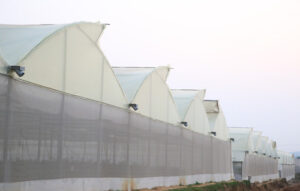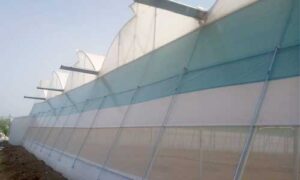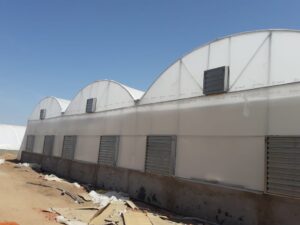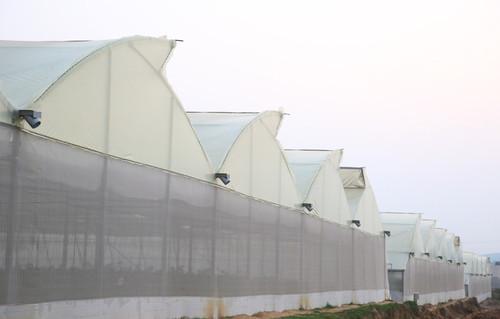.India Government will provide five types of Natural Ventilation Polyhouse
-
Natural Ventilated Polyhouse
-
Poly house
-
Fan Pad Polyhouse
-
Polyhouse vs Greenhouse
-
Agriculture polyhouse farming
As a provider of Natural Ventilation Polyhouse, we offer clients to participate actively to involve.
-
Natural Ventilated Polyhouse :
Naturally Ventilated polyhouse structure mostly use in India, In crop Vegetables as like cucumber, capsicum and tometo and flowriculture, This is the most basic and traditional type of polyhouse. In this type, there is very minimal control of climatic change. Your plants and crops are mainly at the mercy of the climatic conditions prevailing outside. Although there are a few helping aids like fogger, drip irrigation system, ventilation control polyhouse, and pest control system, they are still not enough to yield off-season crops. polyhouse cost 844 Rs.per square meter in 1 acre polyhouse cost 33,76,000 Rs. Natural ventilated polyhouse top side one meter ventilation for polyhouse to hot air outside in polyhouse.

-
Poly house:
A polyhouse is a type of specialized structure that utilizes the controlled climate condition for the growth of different plants and other farming needs. We use polythene sheets to cover the structure and separate the internal environment from that of the outside. poly house is mostly climate controlled system using fogger and top sprinkler. farmer is start new business in agriculture poly house, to start polyhouse farming. most important topic for polyhouse sheet, 200 micron sheet use in polyhouse farming structure. polyhouse sheet is control – Anti dust, anti fog, light diffuse, uv- blocking system, are available in polyhouse sheet, this sheet is installed in poly house. polyhouse farming price 750 Rs.

- Fan Pad Polyhouse:
They are the more sophisticated types of polyhouses. Fitted with some of the very useful added features including but not limits to, sunlight control, humidity, temperature, etc. These polyhouses prolong the crop period and you can also get some of the most exotic off-season varieties from them. Further more, such polyhouse are also uses in areas to produce crops that are otherwise uncultivatable in those regions. fan pad polyhouse to one wall use pad for Colling and poly house second wall is use for fan, fan is control a temperature in polyhouse.

- Polyhouse vs Greenhouse :
One of the questions that we get quite often is that what is the difference between a greenhouse and a polyhouse. Today we will make this clear and put this confusion to rest. A polyhouse is essentially a greenhouse. It can also be regards as a type of greenhouse.
Traditionally the greenhouses were made with green-color sheets to act as a roof. Then with advancement, we were introduce to more reliable plastic sources such as polythene. The success of this new polythene in a greenhouse as well as its low cost made it a material of choice. That is how this type of greenhouse got a new name, i.e., polyhouse.
- Agriculture polyhouse farming :
know days farmer is done low cost polyhouse with drip systems, polyhouse farming is basically a commercial project for batter production.
Natural ventilation polyhouses:
Natural ventilation in polyhouses involves understanding the basic principles, factors affecting it, and the importance of ventilation for plant growth and development.
Polyhouses, also known as greenhouses or hothouses, glass, plastic, or polycarbonate, are use for growing plants in a controls environment. They are designs to regulate the temperature, humidity, and light levels to create optimal plant growth conditions.
Natural ventilation is an essential component of polyhouse design that allows for the exchange of air between the inside and outside environment. It is the process of using wind and temperature differences to move air in and out of the polyhouse without the use of mechanical systems.
There are several factors that affect natural ventilation in polyhouses, including wind speed and direction, temperature gradients, and the size and orientation of vents. Further more, the design of polyhouses must take into account these factors to ensure adequate ventilation.
Factors affecting natural ventilation in polyhouses:
Several factors can affect natural ventilation in polyhouses.
Here are some of the most significant factors:
- Wind speed and direction: Wind is the primary driver of natural ventilation in polyhouses. The speed and direction of the wind can influence how much air moves in and out of the polyhouse. A higher wind speed can increase the air exchange rate. While wind direction can impact the distribution of fresh air within the polyhouse.
- Temperature gradients: Temperature differences between the inside and outside of the polyhouse can affect the movement of air. Hot air rises, creating an upward flow that can draw in fresh air from vents or other openings. Similarly, cool air can flow from the bottom of the polyhouse and displace warm air.
- Size and orientation of vents: The size and location of vents can impact the amount and direction of air movement within the polyhouse. Vents locates on opposite sides of the polyhouse can create a cross-flow of air, while vents locates near the top of the structure can create a chimney effect that draws warm air out of the polyhouse.
- Plant canopy and density: The density and size of the plants inside the polyhouse can impact the movement of air. A dense canopy can impede air movement, while taller plants can obstruct the flow of air near the ground. Proper plant spacing and pruning can help improve air circulation.
- External environmental conditions: External environmental conditions such as humidity, temperature, and air quality can also impact natural ventilation in polyhouses. High humidity levels can reduce air movement, while temperature differences between the inside and outside of the polyhouse can impact the movement of air.
Overall, understanding these factors and designing polyhouses that consider them is crucial for optimizing natural ventilation and creating optimal growing conditions for plants.
Types of natural ventilation systems in polyhouses:
There are several types of natural ventilation systems uses in polyhouses.
Here are some of the most common types:
- Roof vents: Roof vents locates at the highest point of the polyhouse and designs to release hot air and promote fresh air flow into the polyhouse. They can be manually or automatically operats and come in various sizes and shapes.
- Side vents: Side vents locates on the sides of the polyhouse designs to promote fresh air flow into the polyhouse. They can be manually or automatically operated and come in various sizes and shapes.
- Louvre vents: Louver vents are similar to side vents but designs with angled slats that allow for better control of the direction and amount of airflow into the polyhouse.
- Doors: Doors can promote air movement in and out of the polyhouse. They can be left open or partially open to allow fresh air to flow into the polyhouse.
- Insect screens: Insect screens can be placed over vents and openings to prevent insects and other pests from entering the polyhouse while allowing fresh air flow.
- Windbreaks: Windbreaks are structures outside the polyhouse designs to protect the polyhouse from strong winds. They can help promote a more consistent and controllable airflow within the polyhouse.
- Thermal screens: Thermal screens are used to reduce heat loss in the polyhouse during cooler periods. They can also be uses to reduce the amount of sunlight and heat entering the polyhouse during hot periods.
Natural ventilation systems are critical for maintaining optimal growing conditions in polyhouses. The type and design of the natural ventilation system will depend on the specific needs of the plants being grown, as well as the climate and environmental conditions of the area.
Design considerations for natural ventilation in polyhouses:
When designing a polyhouse for natural ventilation, several factors must be considered.
Here are some of the most important design considerations:
- Orientation: The orientation of the polyhouse is essential for natural ventilation. The polyhouse should orient in a direction that maximizes exposure to prevailing winds to promote fresh air flow into the structure.
- Ventilation area: The size and location of vents are crucial for natural ventilation. The total area of the vents should be sufficient to allow for air exchange between the inside and outside of the polyhouse. Vents should be locates in areas that promote air movement, such as opposite sides of the polyhouse.
- Ventilation control: Ventilation control is important for regulating airflow into and out of the polyhouse. Automated systems that use temperature and humidity sensors can help regulate ventilation based on specific environmental conditions.
- Insect control: Insect screens should use to prevent insects and other pests from entering the polyhouse while allowing fresh air flow.
- Windbreaks: Windbreaks can protect the polyhouse from strong winds disrupting natural ventilation. They should be placed in areas that do not impede fresh air flow into the polyhouse.
- Thermal screens: Thermal screens can use to reduce heat loss in the polyhouse during cooler periods. They can also use to reduce the amount of sunlight and heat entering the polyhouse during hot periods.
- Plant arrangement: The arrangement and spacing of plants inside the polyhouse can affect natural ventilation. Adequate space should be left between plants to promote air movement. And in addition, taller plants should be arrangs in areas where they do not obstruct airflow.
- Roof design: The roof design can impact natural ventilation. A peaked roof or a roof with a curved profile can create a chimney effect that promotes the flow of warm air out of the polyhouse.
Conclusion
Designing a polyhouse for natural ventilation requires careful consideration of several factors. Including orientation, ventilation area, ventilation control, insect control, windbreaks, thermal screens, plant arrangement, and roof design. Proper design can help optimize natural ventilation and promote optimal plant growth conditions.





